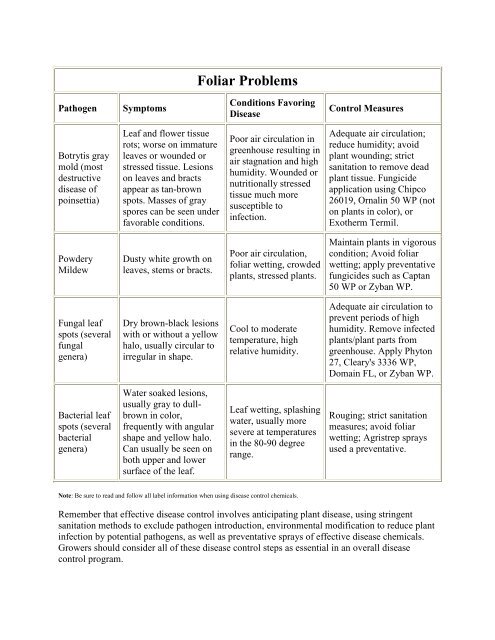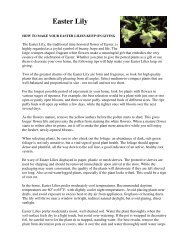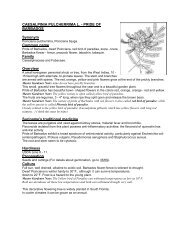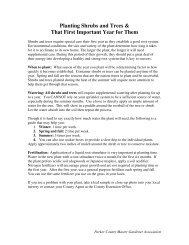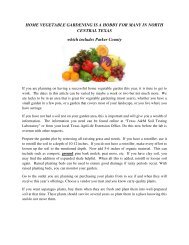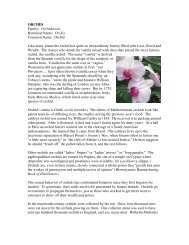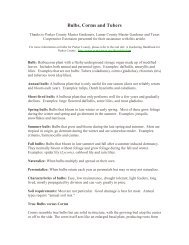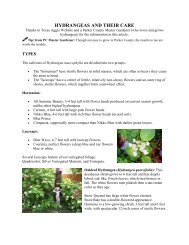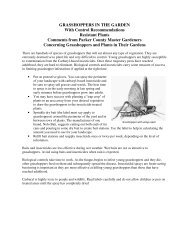Poinsettias
Poinsettias
Poinsettias
Create successful ePaper yourself
Turn your PDF publications into a flip-book with our unique Google optimized e-Paper software.
Foliar Problems<br />
Pathogen<br />
Symptoms<br />
Conditions Favoring<br />
Disease<br />
Control Measures<br />
Botrytis gray<br />
mold (most<br />
destructive<br />
disease of<br />
poinsettia)<br />
Leaf and flower tissue<br />
rots; worse on immature<br />
leaves or wounded or<br />
stressed tissue. Lesions<br />
on leaves and bracts<br />
appear as tan-brown<br />
spots. Masses of gray<br />
spores can be seen under<br />
favorable conditions.<br />
Poor air circulation in<br />
greenhouse resulting in<br />
air stagnation and high<br />
humidity. Wounded or<br />
nutritionally stressed<br />
tissue much more<br />
susceptible to<br />
infection.<br />
Adequate air circulation;<br />
reduce humidity; avoid<br />
plant wounding; strict<br />
sanitation to remove dead<br />
plant tissue. Fungicide<br />
application using Chipco<br />
26019, Ornalin 50 WP (not<br />
on plants in color), or<br />
Exotherm Termil.<br />
Powdery<br />
Mildew<br />
Dusty white growth on<br />
leaves, stems or bracts.<br />
Poor air circulation,<br />
foliar wetting, crowded<br />
plants, stressed plants.<br />
Maintain plants in vigorous<br />
condition; Avoid foliar<br />
wetting; apply preventative<br />
fungicides such as Captan<br />
50 WP or Zyban WP.<br />
Fungal leaf<br />
spots (several<br />
fungal<br />
genera)<br />
Dry brown-black lesions<br />
with or without a yellow<br />
halo, usually circular to<br />
irregular in shape.<br />
Cool to moderate<br />
temperature, high<br />
relative humidity.<br />
Adequate air circulation to<br />
prevent periods of high<br />
humidity. Remove infected<br />
plants/plant parts from<br />
greenhouse. Apply Phyton<br />
27, Cleary's 3336 WP,<br />
Domain FL, or Zyban WP.<br />
Bacterial leaf<br />
spots (several<br />
bacterial<br />
genera)<br />
Water soaked lesions,<br />
usually gray to dullbrown<br />
in color,<br />
frequently with angular<br />
shape and yellow halo.<br />
Can usually be seen on<br />
both upper and lower<br />
surface of the leaf.<br />
Leaf wetting, splashing<br />
water, usually more<br />
severe at temperatures<br />
in the 80-90 degree<br />
range.<br />
Rouging; strict sanitation<br />
measures; avoid foliar<br />
wetting; Agristrep sprays<br />
used a preventative.<br />
Note: Be sure to read and follow all label information when using disease control chemicals.<br />
Remember that effective disease control involves anticipating plant disease, using stringent<br />
sanitation methods to exclude pathogen introduction, environmental modification to reduce plant<br />
infection by potential pathogens, as well as preventative sprays of effective disease chemicals.<br />
Growers should consider all of these disease control steps as essential in an overall disease<br />
control program.


